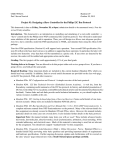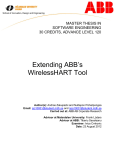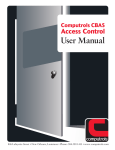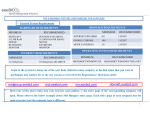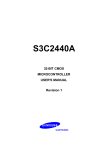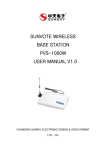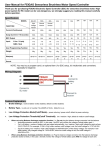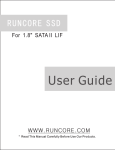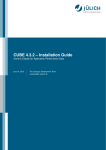Download Design of real-time clock based on ARM embedded system
Transcript
Liao Lijuan COMPUTER MODELLING & NEW TECHNOLOGIES 2014 18(11) 415-418 Design of real-time clock based on ARM embedded system Lijuan Liao* College of Computer Science and Technology, Taiyuan University of Technology, 030024, China Received 1 March 2014, www.cmnt.lv Abstract Real-time clock of ARM processor has disadvantages such as dependence on the processor, low interrupt level and unadjustable accuracy. Linux embedded system based on ARM processor is provided with independent real-time clock using X1227 real-time clock chip. In addition, the work presents transplant of uCLinux system in S3C2440A, procedure of system boot loader and frame of Linux character device driver, thus achieving design of RTC driver based on I2C protocol of uCLinux system. Keywords: S3C2440A, RTC, X1227 The real-time clock integrated in S3C2440A is controlled by INT_RTC and INT_ADC, which have the lowest priority in all the 26 interrupt sources. Besides, this real-time clock is not universal, and cannot run with support of 3.3V voltage and microprocessor. Therefore, external RTC chip X1227 is applied. 1 Introduction Real-time system (RTS) is that correct calculation depends on logical validity of procedure and resulting time. If time constraint of system is not satisfied, the system will go wrong. Then real-time clock is applied to RTS. Software counting can be used to realize function of real-time clock by the timer in ARM processor. However, it is not universal because of the disadvantages including data loss after power down, low interrupt level, unadjustable accuracy, etc. Real-time clock, with independent crystal oscillator and power supply system, can constantly run, thus providing reliable time for RTS and avoiding trouble. By using I2C bus, X1227 real-time clock chip has wide supply voltage range, high interrupt level and adjustable accuracy, thus promoting achievement and correct operation of RTS. 3 RTC chip X1227 3.1 INTERNAL STRUCTURE OF X1227 X1227 is a real-time clock with functions of clock/calendar, CPU monitoring circuit and two-way query and alarm. Dual port clock and alarm register can ensure the accuracy of clock work, even during read and write operation. Clock/calendar can be provided with functions of controlling and reading by registers. Clock can precisely display the time by the unit of second, minute, hour, day, week, month and year using a 32.768 kHz crystal with low cost. There is a watchdog timer in X1227. If the watchdog timer overtimes, the reset pin RESET will be activated. X1227 has an input pin VBACK, using a non-rechargeable battery as the back-up power. A 4K-bit EEPROM array in X1227, used as configuration data memory, will be safe and not affected when the main and standby power supplies lose efficiency. Figure 1 shows block diagram of X1227 consisting of control registers, SRAM, EEPROM, I2C serial interface decoder, status registers, standard crystal, watchdog timer, etc [2]. 2 S3C2440A microprocessor S3C2440A microprocessor of Samsung Corporation is applied to embedded system using a new bus structure— Advanced Micro controller Bus Architecture (AMBA). The CPU is a 16/32-bit ARM920T RISC processor designed by Advanced RISC Machines (ARM). ARM920T has a cache architecture consisting of MMU, AMBA BUS and Harvard. The architecture has independent 16KB instruction and 16KB data caches comprising eight-byte lines. S3C2440A is provided with a complete set of common system peripherals to reduce cost of the whole system and additional components [1]. * Corresponding author e-mail: [email protected] 415 Information and Computer Technologies Liao Lijuan COMPUTER MODELLING & NEW TECHNOLOGIES 2014 18(11) 415-418 FIGURE 1 Block diagram of X1227 3.2 MAIN FUNCTIONS OF X1227 4 Transplant of uclinux system to S3C2440A RTC of X1227 uses a external quartz crystal with a frequency of 32.768 kHz to keep accuracy of year, month, day, week, hour, minute and second. RTC, with century byte, can adjust leap years, the months less than 31 days, and the form of time by one bit. After format conversion, data of CCR in form of BCD code should be read and written by I2C interface in X1227. There are two alarm registers in X1227. If the time set by alarm register is the same with RTC, the corresponding position of SR register in CCR will be set to 1, thus realizing timing alarm. There are four KEEPROMs in X1227. They will be used to store key data of self-check program and system when system is power off. WatchDog can be set to control the shortest time of feeding the dog by writing WD1, WD0 of BL register in CCR. When the procedure comes into endless loop because of external disturbance, and timing register reaches maximum, WatchDog will emit a signal to reset SCM, thus the procedure is in control again. X1227 is connected with S3C2440A using I2C interface (See Figure 2). Serial data pin (SDA), as a bi-pin connected with external 330Ω pull-up resister, is used to input and output data to the device. Input of serial clock pin (SCL) is used to time the whole data of input and output devices, thus providing serial clock signals of data transmission. VCC and VBACK inputs are received by the power control circuit of X1227. If VCC< VBACK-0.2V, then the power will be switched to VBACK by the power control circuit; if VCC>VBACK, then it will return to VCC. 4.1 UCLINUX SYSTEM Uclinux (micro-control linux), as a Linux system in microcontrol field, is a major product of Lineo Corporation and a model for embedded Linux of open source. Aiming at the target processor of embedded system without MMU (Memory Management Unit), uclinux is designed and successfully transplanted to platforms. The users of uclinux operation system can apply the whole Linux API functions based on GNU general license. After clipping and optimization, uclinux forms an embedded Linux with high optimization and compact codes. Uclinux has advantages such as small size, stability, good transplant, excellent network function, perfect support to all the file systems and abundant API functions. Therefore, uclinux has good compatibility with Linux. API functions of uclinux, except fork(), are the same as those of standard Linux [3]. 4.2 ESTABLISHMENT OF CROSS-COMPILING ENVIRONMENT Cross-compiling environment used for target machine is established in PC because of limited storage of common embedded system. The executable files, got from compilation, connection and location of procedure in PC, are loaded to the target machine through serial port. Crosscompiling environment is required to establish kernel header files, binutils, bootstrap gcc, glibc, etc. The work applies the method as follows. Firstly, GCC is installed in PC aiming at compiler of ARM (arm-elf-gcc). Secondly, the configured cross tool chain "arm-elf-tools20040427.sh" provided in "www.uclinux.org" is convenient to use. In the root directory, after adding the executed authority by running command "#chmod 755 arm-elf-tool-20040427.sh", the script can be operated to install cross tool chain in correct position. At last, the address "/user/local/bin" is checked to identify whether the compiling environment file started with "arm-elf-" is existed or not. If so, then cross-compiling environment VCC VCC R1 330 X1227 3. 3V 1 2 3 4 VBack VCC X1 X2 SCL SDA VSS RE SET 8 7 6 5 GPE 14 GPE 15 RE SET S3C2440A 32. 768k FIGURE 2 X1227 connected with S3C2440A 416 Information and Computer Technologies Liao Lijuan COMPUTER MODELLING & NEW TECHNOLOGIES 2014 18(11) 415-418 struct file_operations { ssize_t(*read)(struct file *, char *, size_t, loff_t *); sszie_t(* write)(struct file *, const char *,size_t, loff_t *); int(* ioct1)(struct inode *, struct file *, unsigned int,Unsigned long); int(* open)(struct inode *, struct file *); int(* release)(struct inode *, struct file*); ...}; will be successfully installed. The program above is actually procedure of establishing uclinux library file. 5 Driving X1227 in unlinux system 5.1 SYSTEM BOOTSTRAP ROUTINE BOOT, as the first running line of code in the chip after power on, is applied to initialize running environment of hardware and software in system for application program operation. System bootstrap routine boots up operation system and hands the control power over to operation system core. This operation depends on the type of CPU core and the resource applied to develop embedded system software in CPU chip. Figure 3 shows the flow of system boot loader based on this chip and application program. The driver should realize the following functions: 1) open( ) Initialize the devices supported by the driver. 2) release( ) Close the devices supported by the driver after use. 3) read( ) Read data from character devices by application program or Linux. 4) write( ) Write multiple byte data to character devices. 5) ioctl( ) Provide application program with some special operation which cannot be easily realized by read() and write() methods. The above methods derive the functions as follows: initialization, load and release of hardware devices; management of equipment including setting real-time parameter and providing unified operation interface for devices; reading data of device files obtained from (or responding to) application program; detecting or processing device errors. Reset Setup entrance pointer of a program Set the interrupt vector table Initial various Peripherals In the chip Initial object board Initial different patterns of stack and registers in CPU 5.3 DESIGN OF X1227 DRIVER Call the main program X1227 can communicate with ARM by I2C bus. Using signal wires SCL and SDA, I2C bus can achieve data interaction between devices, thus simplifying occupation of hardware resources and PCB wiring space. I2C bus realizes data transmission and command control by timing signals including start, stop and ACK. If SCL is at the high level and SDA switches from high to low level, I2C bus will start sending signals; if SCL is at the high level and SDA switches from low to high level, it will stop sending signals; if the device receives 8-bit data, it will send ACK to the sender. Then the sender will set SDA at the high level, and the receiver will set SDA at the low level during responsive clock pulse, thus achieving signal response. Figure 4 shows start condition, stop condition and ACK of I2C bus [5]. FIGURE 3 Flow of the system boot loader 5.2 DRIVER FRAMEWORK OF LINUX CHARACTER DEVICE X1227 as well as alarm clock is set and read by compiling software. As a hardware device of system running in Linux, X1227 is operated by drivers in Linux operation system. The devices in Linux include character and block. X1227 is a character device. Programs of user mode can run character devices like common files. Therefore, the driver of character device type should at least realize system call functions including open(), release(), read() and write(). In Linux kernel, X1227 character driver is designed based on the framework as follows [4]. FIGURE 4 I2C bus X1227 has slave device addresses including 1010 (access to 4KB EEPROM) and 1101 (access to CCR) used to control RTC and WatchDog. Figure 5 shows operation of a byte access including a slave address byte, an address 417 Information and Computer Technologies Liao Lijuan COMPUTER MODELLING & NEW TECHNOLOGIES 2014 18(11) 415-418 word (16 bits) to be accessed and an 8-bit operand. The last bit of the slave address byte determines this operation. If the last bit is 1, the reading will be conducted; if 0, writing EEPROM Write START Word Address 1 1 0 1 0 0 0 0 0 0 0 0 0 1 1 1 1 1 0 1 1 CCR Read ACK will be operated. The communication process of I2C bus is simulated using I/O interface. Firstly, slave address of I2C bus is defined to read and write devices by program. Word Address 0 ACK Data ACK STOP ACK FIGURE5 Access format of X1227 # define RTC_I2C_READ 0xaf //Read the address by I2C bus # define RTC_I2C_WRITE 0xae // Write the address by I2C bus RTC driver module applies character devices achieved by “struct file_operation” framework structure: static struct file_operations x1227_fops = { .owner = THIS_MODULE, .ioctl = x1227_ioctl, .open = x1227_open, .release = x1227_release, }; RdBy_Iic(0xd e,0x31 , &(rdata)) ; / / Read minute register dbuf[1] = rdata; … RdBy_Iic(0xd e,0x35,&(rdata)) ; / / Read year register dbuf[5] = rdata; copy_to_user (buffer,dbu, f6) ; / / Change data from kernel to user mode …} Function rtc_write() is mainly used to set time and date. The compiled program can be re-compiled using crosscompiling tool of uclinux for operation in S3C2440A. In Windows, uclinux kernel, root file system and executed file are read and written through serial port of hyperterminal. Basic settings are as follows: baud rate is 115200; data bit number 8; no parity checking; stop bit 1; no data flow control. In this structure, the whole functions are accomplished by upper call function ioct1 [6]: int x1227_ioctl(struct inode *inode, struct file *filp, unsigned int cmd, unsigned long arg) In the function, reading and writing transmission commands of cmd are “RTC_RD_TIME” and “RTC_SET_TIME”; arg is the structure pointer directing to “struct rtc_time” for time storage. At first, the function reads transmission command cmd to determine whether the operation is writing or reading. If the result is reading, then Function rtc_read() will be called to read data from the register and keep them in arg; else if writing, then Function rtc_write() will write data to the register. Function rtc_read() can be used to read the time and date in RTC register, achieved by the following function: 6 Conclusions RTC is one of the typical applications of I2C in embeded products. Even if there is no special I2C interface to control processor chip, I2C bus time sequence will be simulated by software to achieve communication between chips with two I/O interface pins. Therefore, RTC is suitable for embedded devices. The work aims at designing driver of X1227 clock chip to achieve real-time clock combined with RTC device driver model in uclinux. The design realizes real time of system by replacing the integrated clock in CPU. The designed clock has a good performance in running and function, thus proving practicability and stability of this driver design. rtc_r ead (struct file * filep, cha r * buffer, size_t length) {… Init_Iic( ) ; / / Initialize I2C bus RdBy _Iic( 0xde, 0x30, & (rdata) ) ; / / Read second register dbu f[0] = rdata ; References [1] Samsung Electronics Co Ltd 2004 S3C2440A 32-BIT RISC Microprocessor User’s Manual Korea Revision 0.12 Samsung Electronics Co Ltd [2] Intersil Corporation 2005 2-Wire RTC Real Time Clock/Calendar/CPU Supervisor with EEPROM X1227 Datasheet [EB/OL] http://www.intersil.com/ [3] Corbet J, Kroah-Hartman G, Rubini A 2005 Linux Device Drivers 3rd Edition O’Reilly 49-53 [4] Bovet D P 2002 Understanding the Linux Kernel 2nd Edition O’Reilly [5] Philips Semiconductors 2003 AN10216-01 I2C Manual 13-7 [6] Nilsson J, Rytterlund D 2000 “Modular Scheduling in Real-Time Linux” MSc Thesis Department of Computer Engineering Idt Malardalen University Author Lijuan Liao, born in September, 1963, Hengyang, Hunan Province, China Current position, grades: associate professor in College of Computer Science and Technology, Taiyuan University of Technology, China. Scientific interests: computer control and embedded technology. Publications: 20 papers. 418 Information and Computer Technologies




